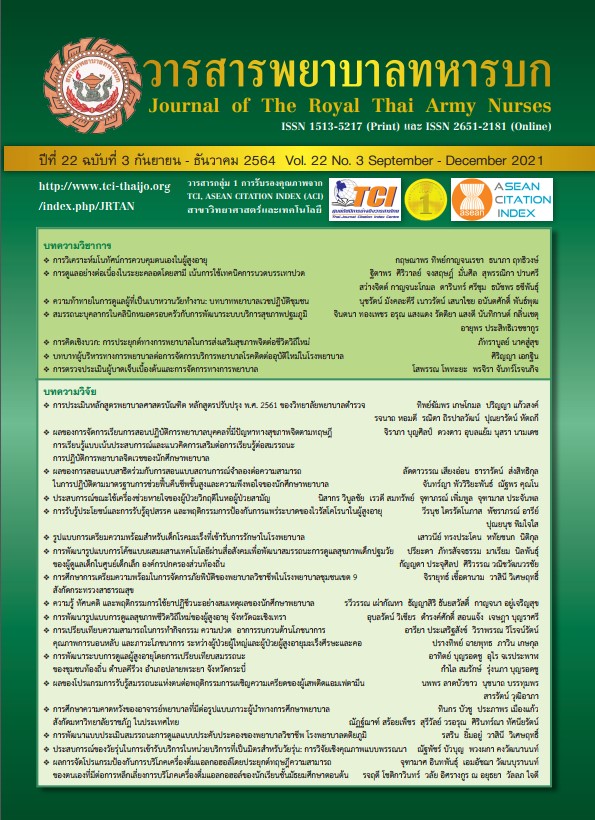Lower Urinary Tract Symptoms, Symptom Management, and Psychological Well-Being among Older Adults with Benign Prostatic Hyperplasia: A Correlational Study
Keywords:
Benign Prostatic Hyperplasia, Lower Urinary Tract Symptoms, Symptom Management, Psychological Well-Being, Older AdultsAbstract
This descriptive correlational study aimed to examine the relationship among lower urinary tract symptoms (LUTS), symptom management, and psychological well-being (PWB) in older adults with benign prostatic hyperplasia (BPH). The study was conducted on 130 older adults who were follow-up at a university hospital located in Bangkok and met the inclusion criteria as follows: being 60 to 84 years of age; being diagnosed with BPH; and being cognitively intact. Data were obtained using The Demographic Data and Health Information Questionnaire; The Thai Version of The International Prostate Symptom Score; The Urinary Symptom Management Inventory; and The Psychological Well-Being Questionnaire. Data were analyzed using descriptive statistics and Spearman rank correlation coefficient. Results revealed that The LUTS had a low negative relationship with PWB, and urinary symptom management had a low positive relationship with PWB (r s = -.22, p < .05; r s = .20, p < .05, respectively).
Downloads
References
Suppaso M. Urinary Symptoms management experiences among the older people with benign prostate hyperplasia. (Thesis). Khon Kaen: Khon Kaen University; 2014. (in Thai)
Santingamkun A. Benign prostatic hyperplasia (BPH). In: Choonhaklai V, Santingamkun A, editors. Common urologic problems for medical student. Bangkok: Beyond the company’s Terry Price; 2015. (in Thai)
Roehrborn CG. Male lower urinary tract symptoms (LUTS) and benign prostatic hyperplasia (BPH). Medical Clinics of North America. 2011; 95(1):87-100.
Oelke M, Bachmann A, Descazeaud A, Emberton M, Gravas S, Michel MC, et al. EAU guidelines on the treatment and follow-up of non-neurogenic male lower urinary tract symptoms including benign prostatic obstruction. European Urology. 2013; 64(1):118-40.
Patel ND, Parsons JK. Epidemiology and etiology of benign prostatic hyperplasia and bladder outlet obstruction. Indian Journal of Urology. 2014;30(2):170-6.
Rohrmann S, Katzke V, Kaaks R. Prevalence and progression of lower urinary tract symptoms in an aging population. Urology. 2016;95: 158-63.
Egan KB. The epidemiology of benign prostatic hyperplasia associated with lower urinary tract symptoms. Urologic Clinics of North America. 2016;43(3):289-97.
Stroup SP, Palazzi CK, Kopp RP, Parsons JK. Trends in adverse events of benign prostatic hyperplasia (BPH) in the USA, 1998 to 2008. BJU International. 2012;109(1):84-87.
Jongwannasiri M, Chintapanyakun T, Viseshsindh W. Compared position of urination on uroflowmetry and post void residual in patient with benign prostatic hyperplasia (BPH). Journal of The Royal Thai Army Nurses. 2020; 21(1):176-82. (in Thai)
Medical Record Unit (2014-2016) Annual statistics report, Bangkok: Medical statistics unit, Medical record and statistics division, Faculty of medical Ramathibodi hospital, Mahidol university. (in Thai)
Parnham A, Haq A. Benign prostatic hyperplasia. Journal of Clinical Urology. 2013; 6(1):24-31.
Coyne KS, Wein AJ, Tubaro A, Sexton CC, Thompson CL, Kopp ZS, et al. The burden of lower urinary tract symptoms: evaluating the effect of LUTS on health-related quality of life, anxiety and depression: EpiLUTS. BJU International. 2010;103(3): 4-11.
Fourcade RO, Lacoin F, Roupret M, Slama A, Le FC, Michel E, et al. Outcomes and general health-related quality of life among patients medically treated in general daily practice for lower urinary tract symptoms due to benign prostatic hyperplasia. World Journal of Urology. 2012;30(3):419-26.
Dodd M, Janson S, Facione N, Faucett J, Froelicher ES, Humphreys J, et al. Advancing the science of symptom management. Journal of Advanced Nursing. 2001;33(5): 668-76.
Ryff CD, Keyes CM. The structure of psychological well-being revisited. Journal of Personality and Social Psychology. 1995;69(4):719-27.
Wichitsiri P. Wisdom social support and psychological well-being of elderly in the elderly club at Wat Sarod Rat Burana District Bangkok. (Thesis). Bangkok: Kasetsart University; 2012. (in Thai)
Suppaso M. Urinary Symptoms management experiences among the older people with benign prostate hyperplasia. (Thesis). Khon Kaen: Khon Kaen University; 2014. (in Thai)
Aree-Ue S, Youngcharoen P. The 6 item cognitive function test-Thai version: psychometric property testing. Rama Nurs J. 2020;26(2): 188-202. (in Thai)
Nontakaew K, Kochakarn W, Kijvikai K, Viseshsindh W, Silpakit C. Reliability of a Thai version of the international prostate symptom score (IPSS) for the Thai population. Journal of the Medical Association of Thailand Chotmaihet thangphaet. 2014; 97(6):615-20. (in Thai)
Pinto JO, He HG, Chan SC, Toh PC, Esuvaranathan K, Wang W. Health related quality of life and psychological well-being in patients with benign prostatic hyperplasia. Journal of clinical nursing. 2015;24(3-4):511-22.
Matsushita C, Torimoto K, Goto D, Morizawa Y, Kiba K, Shinohara M, et al. Linkage of lower urinary tract symptoms to sleep quality in elderly men with nocturia: A community based study using home measured electroencephalogram data. The Journal of Urology. 2017;197(1):204-9.
Helfand BT, McVary KT, Meleth S, Sharp V, Foster H, Naslund M, et al. The relationship between lower urinary tract symptom severity and sleep disturbance in the CAMUS trial. The Journal of Urology. 2011;185(6):2223-8.
Lee VW, Leung TP, Lee VW. Outpatient medication use in Chinese geriatric patients admitted for falls: A case–control study at an acute hospital in Hong Kong. American journal of therapeutics. 2016;23(6):e1729-e35.
Kardasevic A, Milicevic S. Correlation of subjective symptoms in patients with benign prostatic hyperplasia and erectile dysfunction. Medical Archives. 2017;71(1):32-6.
Bechara A, Romano S, Casabe A. Lower urinary tract symptoms and erectile dysfunction from urological consultation in Argentina. Archivos espanoles de urologia. 2013;66(10):917-24.
Cho MC, Kim JK, Song SH, Cho SY, Lee SW, Kim SW, et al. Patient-reported ejaculatory function and satisfaction in men with lower urinary tract symptoms/benign prostatic hyperplasia. Asian Journal of Andrology. 2018; 20(1):69-84.
Fwu CW, Kirkali Z, McVary KT, Burrows PK, Eggers PW, Kusek JW. Cross-sectional and longitudinal associations of sexual function with lower urinary tract symptoms in men with benign prostatic hyperplasia. The Journal of Urology. 2015;193(1):231-8.
Chao S, Chippendale R. Benign prostatic hyperplasia and prostate cancer. In: Williams BA, Chang A, Ahalt C, Chen H, Conant R, Landefeld CS, et al., editors. Current diagnosis and treatment: Geriatrics, 2nd ed. New York, NY: McGraw-Hill Education.2014.
Egan KB. The epidemiology of benign prostatic hyperplasia associated with lower urinary tract symptoms. Urologic Clinics of North America. 2016;43(3):289-97.
Jisabai J, Hunnirun P, Tornee S. Self-care behaviors and quality of life of the elderly people in the elderly people club, Bangkoknoi District Bangkok Metropolitan. Journal of Faculty of Physical Education. 2012;14(1):214-25. (in Thai)
Thongsuk Y. Factors influencing psychological well-being among older adults. (Thesis). Chonburi: Burapha University; 2016. (in Thai)
Subprawong K. Psychological well-being of the Thai elderly. BU Academic Review. 2012; 11(2):99-110. (in Thai)
Downloads
Published
How to Cite
Issue
Section
License
บทความหรือข้อคิดเห็นใดใดที่ปรากฏในวารสารพยาบาลทหารบกเป็นวรรณกรรมของผู้เขียน ซึ่งบรรณาธิการหรือสมาคมพยาบาลทหารบก ไม่จำเป็นต้องเห็นด้วย
บทความที่ได้รับการตีพิมพ์เป็นลิขสิทธิ์ของวารสารพยาบาลทหารบก
The ideas and opinions expressed in the Journal of The Royal Thai Army Nurses are those of the authors and not necessarily those
of the editor or Royal Thai Army Nurses Association.






